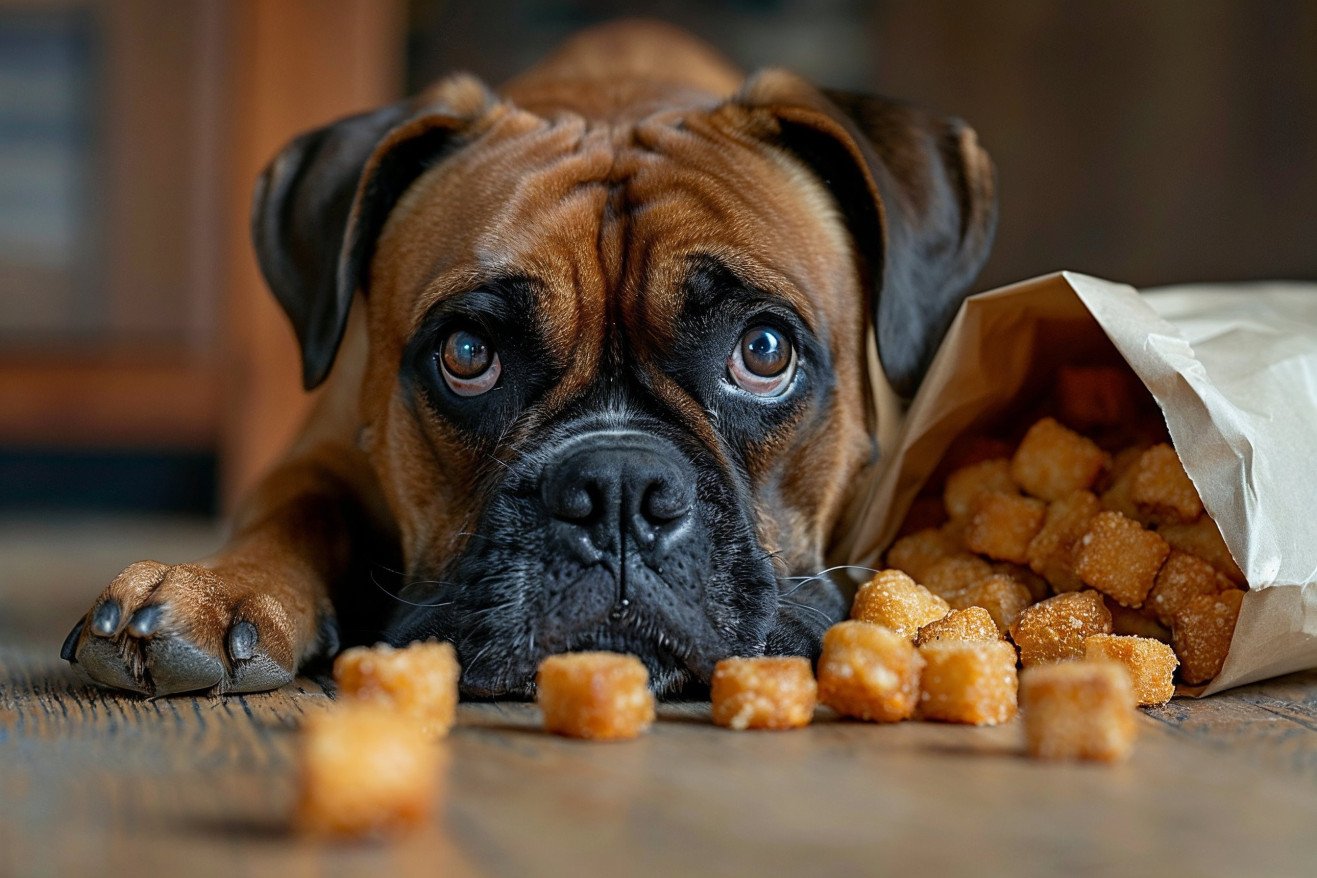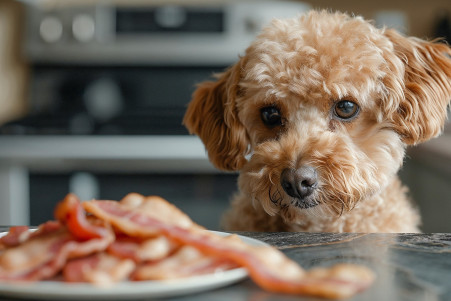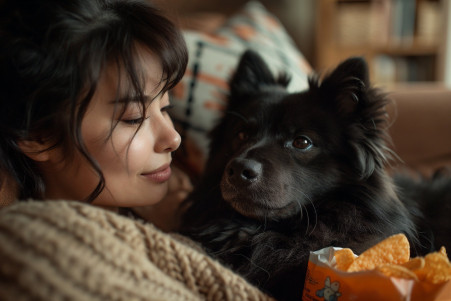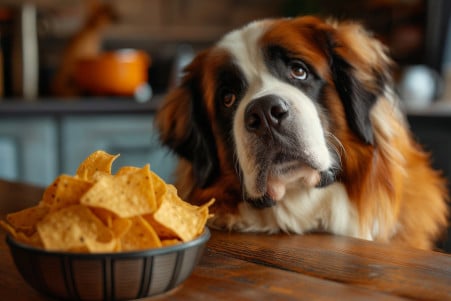Can Dogs Eat Pork Rinds? Uncovering the Risks and Safe Alternatives
20 February 2024 • Updated 19 February 2024

While pork rinds may be a delicious snack for humans, they are not safe for dogs to eat. This is because pork rinds are high in fat and salt, which can cause health issues such as obesity, pancreatitis, and salt poisoning. Furthermore, the seasonings used to flavor pork rinds can be harmful to dogs. Therefore, it’s best to stick to healthier dog-friendly treats.
In order to fully understand the nuances of dog nutrition and the effects of human food like pork rinds on dogs, we will explore evidence from veterinary medicine, animal nutrition, and dog diet studies.
We will walk you through insights and suggestions from experts, shedding light on the qualities that make a treat healthy and safe for your pet. Our hope is to give you the information you need to make sure your dog’s treats are a positive part of their overall health and wellness.
Can dogs eat pork rinds?
Pork Rinds and Your Dog’s Nutritional Requirements
Pork rinds are a popular snack because of their crispy texture and salty taste, but they are not a good option for your dog. Pork rinds are high in fat and sodium, which can be dangerous for dogs. If dogs eat pork rinds, they can become overweight and get pancreatitis from the fat, and salt poisoning can occur from the high sodium content.
Dogs have specific nutritional needs that must be met, according to VCA Animal Hospitals. Dogs require proteins, fats, essential amino acids, vitamins, and minerals in certain ratios to stay healthy. While dogs are omnivores and can eat a variety of foods, the high fat and sodium content of pork rinds doesn’t meet their nutritional requirements.
This shows the difference between the high-fat, high-sodium nature of pork rinds and what dogs actually need to eat to stay healthy. By feeding dogs pork rinds, their nutritional balance is thrown off, which can lead to long-term health problems. This also shows that just because a food is safe for people to eat, that doesn’t mean it’s safe or healthy for dogs.
Health Risks of Feeding Pork Rinds to Your Dog
Feeding your dog high-fat treats such as pork rinds can have serious health consequences. According to PetMD, while fats are an important part of a dog’s diet, they need to be consumed in the right context. High-fat diets can lead to pancreatitis, an extremely painful condition in which the pancreas becomes inflamed and requires immediate medical attention.
In addition, obesity is a major risk factor and can lead to joint problems, diabetes, and a shorter life span.
The high sodium levels in pork rinds can also be problematic and can even lead to salt poisoning, according to the Merck Veterinary Manual. If your dog has salt poisoning, they may experience vomiting, diarrhea, seizures, and in some cases, death.
LoveToKnow Pets notes that it’s important to seek veterinary care right away if you suspect salt poisoning, especially if your dog is showing signs of abdominal pain, depression, or tremors after eating something salty.
The seasonings that are often used on pork rinds, such as onion and garlic, can also be problematic and can lead to toxic reactions. The best way to avoid these risks is to keep these types of snacks away from your dog and instead feed them treats that are healthier and more appropriate for their species. It’s important to be mindful of what you’re feeding your dog to ensure their long-term health and well-being.
Understanding How Pork Rinds Affect Your Dog’s Digestive System
According to the Veterinary Teaching Hospital at Washington State University, a dog’s digestive system includes the mouth, teeth, salivary glands, esophagus, stomach, intestines, pancreas, liver, and gallbladder. This system is designed to break down food and absorb nutrients effectively. However, it’s not designed to handle the high fat content of pork rinds. Consuming too much fat can overwhelm the digestive system, leading to digestive upset, including diarrhea, or more serious issues like pancreatitis.
Pork rinds are even more problematic because of the seasonings and other ingredients that are often added to them. A study in PMC found that dogs can experience oxidative damage that can result in symptoms like vomiting and diarrhea from some of the ingredients in pork rinds, including onions and garlic, which are commonly used.
The cooking and processing of pork rinds doesn’t remove these toxic substances, so flavored pork rinds can be especially dangerous.
To help ensure your dog’s digestive health, make sure they’re eating a diet that meets their specific nutritional requirements and doesn’t include high-fat treats like pork rinds. It’s important to make sure the food you’re feeding your dog has an appropriate fat content and doesn’t include any harmful additives to help ensure their overall health and digestive well-being.
Obesity in Dogs: A Weighty Problem
Obesity in dogs is a serious problem, and a study from the American Veterinary Medical Association found that dogs who are overweight may die up to 2 1/2 years earlier than dogs who are at a healthy weight. High-fat treats like pork rinds are a major contributor to the obesity epidemic in dogs, and obesity has been shown to lead to a number of health issues.
A study in the Journal of Veterinary Internal Medicine found that obesity can shorten a dog’s life and increase the risk of chronic diseases like diabetes, heart disease, and osteoarthritis.
To help ensure a dog’s overall health, it’s important to make sure they stay at a healthy weight through a combination of a healthy diet and regular exercise.
The Clinical Nutrition Service at Cummings School even references a study that shows that leaner Labrador Retrievers not only live longer but also have a longer period before the onset of chronic diseases.
To prevent and treat obesity in dogs, it’s important for dog owners to monitor their dogs’ food intake, choose low-fat, healthy treats, and make sure their dogs get enough exercise. By making sure your dog stays healthy with these steps, you can help them live a longer, healthier life that’s free from the challenges of obesity.
Healthy Snacks for Dogs
If you want to spoil your dog with a treat, it’s important to make sure that you’re giving them something healthy instead of pork rinds. According to Spruce Pets, some of the best healthy alternatives include carrots, green beans, and certain fruits. Not only do these options meet the dietary needs of dogs, but they also provide important vitamins and minerals.
Of course, dog treats that are made specifically for dogs are formulated to meet their dietary needs. For example, the American Kennel Club says that plain, unseasoned, boiled chicken is a good alternative because it’s high in protein, easy to digest, and contains the nutrients that dogs need without the fat and salt that pork rinds have.
While it’s good to mix things up for your dog, it’s important to remember that you should still feed them alternative snacks in moderation. When you introduce new snacks, make sure to do so slowly to make sure that your dog can tolerate them and to watch for any negative side effects.
By doing this, you can ensure that your dog maintains a balanced diet and healthy lifestyle, which will help them stay happy and healthy for years to come.
Conclusion: Pork Rinds and Dogs
Veterinarians and animal nutritionists are in complete agreement on one thing: pork rinds are not a safe snack for dogs. As outlined by Hepper, Spoiled Hounds, and LoveToKnow Pets, the high fat and sodium content of pork rinds can cause obesity, pancreatitis, and salt toxicity in dogs. And, of course, the seasonings can also be harmful to dogs and make the other risks even worse.
It’s clear that giving pork rinds to dogs is a risk that pet owners should avoid. Instead, it’s important to make sure that you’re feeding your pet in a way that meets their dietary needs and that you’re giving them treats that are in line with their nutritional requirements. That means that pet owners should choose healthier options to make sure that their dogs stay safe and healthy.
In the end, the road to a long and healthy life for our dogs is paved with the treats we choose for them. This road requires that we keep our dogs’ dietary restrictions in mind and prioritize their long-term health over short-term satisfaction. In doing so, we can help them maintain not just their physical health but also the strong bond we share with them.


